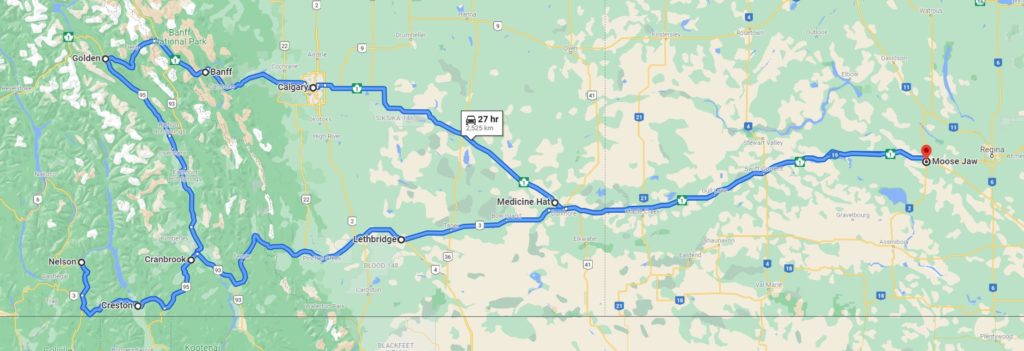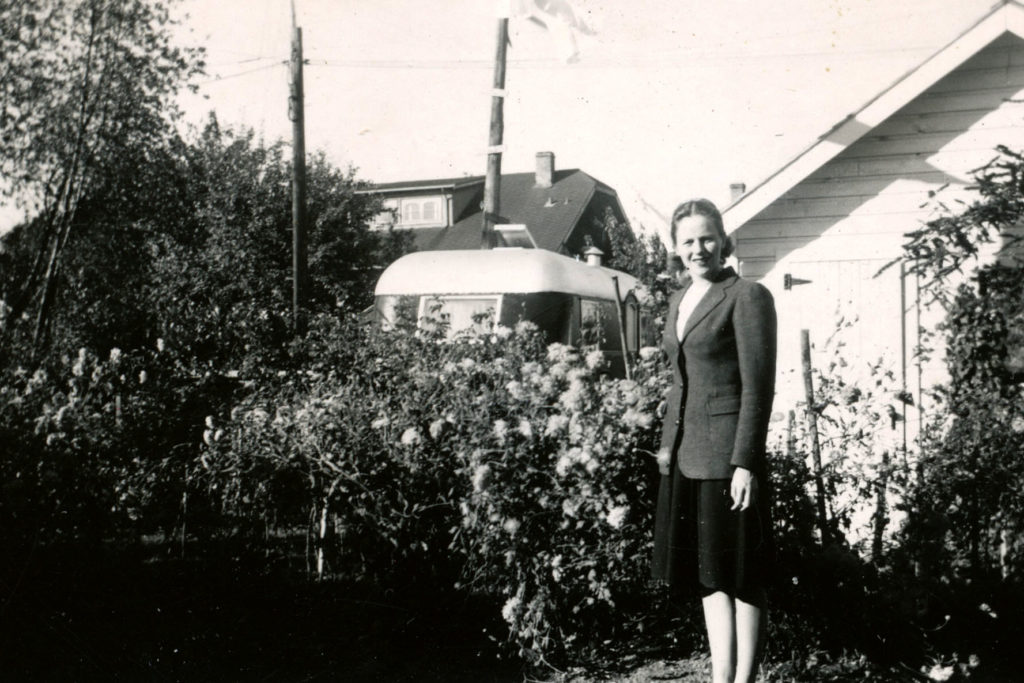
Canada Road Trip, 1926
In July of 1926 our grandparents, Harold and Vera Johnston, then in their early 30s, loaded their three young daughters into the family automobile and headed west from Moose Jaw, Saskatchewan, on their way to Kootenay Lake in British Columbia. Their eldest daughter, Marjorie, was six at the time; Mary was almost three; and our mother, Catherine, was 20 months old and prone to car sickness. A young woman named Margaret Gates joined the family to help with the children.

This trip was possible for the Johnstons mostly because American automobile manufacturer Henry Ford had recently developed an assembly-line method for mass producing his Model A automobile. This brought the price of a family car down dramatically.

Also, the economy was booming between the end of World War I in 1918 and the beginning of the Great Depression of 1929. As a result, tens of thousands of Canadians were hitting the roads for camping vacations, with canvas tents, camp stoves, and kitchen boxes strapped to the car’s roof and both bumpers.
The trip was also possible because of a massive effort to build roads and highways across Canada. The Trans-Canada Highway was close to completion in the mid- to late 1920s. The quality of the roads varied widely, however. Some were impassable after a hard rain; others, notably those built by the federal government in the national parks, were excellent for the times.
As is evident from several black-and-white snapshots taken on their journey, special clothing was being mass produced and marketed for campers. The women and girls in the Johnston excursion are most often dressed in loose-fitting, knee-length camping knickers – sometimes worn with knee-high stockings – and blousy shirts. Grandpa Johnston’s travel apparel looks like dress shirts and trousers, but they were likely made from special fabric designed for “roughing it”.

By the 1920s, cars were relatively comfortable for long trips, with inflatable tires, suspension systems, upholstered seats, and a passenger space enclosed with a roof and windows. The snapshots don’t show where the Johnston family slept during their travels. Free-standing tents made of heavy canvas were common camping shelters. But elaborate set-ups for attaching a tent to one or both sides of a car roof were also popular at the time.
A few of Grandpa’s black-and-white photographs had brief, penciled comments about people and places on the back. Using these small bits of evidence, I made a guess about the probable travel route from the place names. I decided that the trip sequence was most likely Moose Jaw, Calgary, Banff, Golden, Cranbrook, Nelson, Blairmore, Maple Creek, Moose Jaw. It could just as easily have been the reverse. The ages of the children, Marjorie and Mary’s cropped haircuts, and the camping outfits the family wore, made me pretty confident that all the photos were of the same July 1926 adventure.

See our Road Trip 1926 Gallery for more photos and details about the Johnstons’ travel adventure.
Grandpa and Grandma Johnston continued their road trips into the 1950s. They hauled their wonderful little trailer, “Daisy Mae”, from Calgary down to Southern California to visit us a few times. And our mom continued the road trip tradition. With a small inheritance from her godparents in the 1950s, she purchased a little travel trailer that she named “Gypsy”, after a small, horse-drawn wooden house on wheels, in English novelist Kenneth Grahame’s 1908 book, The Wind in the Willows. Obviously, our car then needed a suitably English name, and Mom decided on “Cyril”.




With Gypsy in tow, Cyril carried our large family on many happy weekends and vacations in the great outdoors. Borrego Springs in Anza-Borrego Desert State Park, and at San Clemente Beach State Park on the Southern California coast were two favorite spots. Between trips, Dad kept the the 1954 Dodge Coronet Sierra station wagon running, and Mom kept the trailer ready for travel.
In 2014, our sister Marnie, and her husband, Erik, followed in our parents and grandparents’ footsteps and purchased a large, comfortable Airstream. They used it for several years, heading to California and Arizona desert country to escape the dreary Pacific Northwest winters. They named their trailer “Gypsy” and their car “Cyril” after our mom and dad’s modest 1950s rig.
Historical Tidbits
The automobile was one of those inventions that changed nearly everything about most people’s daily lives. The two stories below document that huge transition in different ways.
Let the Pedestrian Beware
Archival photos from The Detroit News tell the hair-raising tale of taming traffic in Detroit in the years before stop signs, traffic lights, center lines, speed limits, or pedestrian right-of-way laws:
1900-1930: The years of driving dangerously
The Canadian Encylopedia has a great article about how the Canadians successfully battled the U. S. Ford Motor Company for a share of the world automobile market:


One response to “”
Love this post! It’s hard to believe the two close-cropped children with Mom are her sisters; their haircuts make them look like young boys.